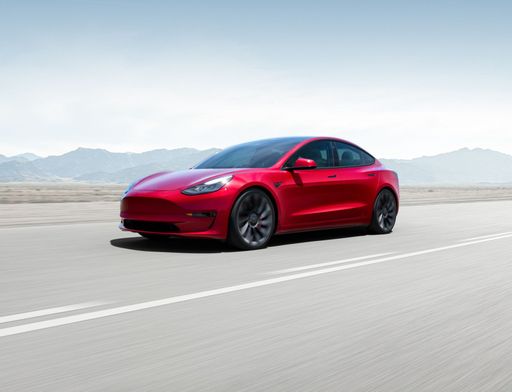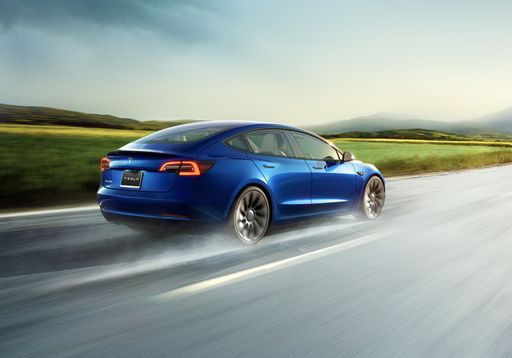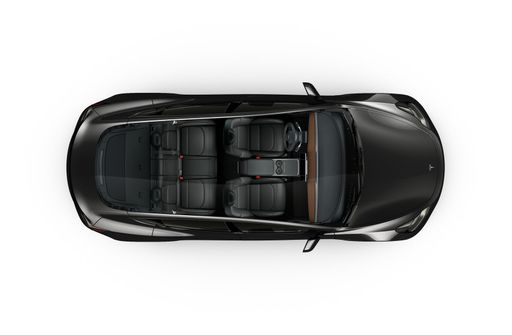Elaris Jaco vs Tesla Model 3 – Differences & prices compared
Compare performance, boot space, consumption and price in one view.
Find out now: which car is the better choice for you – Elaris Jaco or Tesla Model 3?
The Elaris Jaco () comes with a engine and transmission. In comparison, the Tesla Model 3 (Sedan or Hatchback) features a Electric engine with Automatic transmission.
When it comes to boot capacity, the Elaris Jaco offers , while the Tesla Model 3 provides 594 L – depending on how much space you need. If you’re looking for more power, decide whether the of the Elaris Jaco or the 460 HP of the Tesla Model 3 suits your needs better.
In terms of consumption, the values are per 100 km for the Elaris Jaco, and 13.20 kWh for the Tesla Model 3.
Price-wise, the Elaris Jaco starts at , while the Tesla Model 3 is available from 34300 £. Compare all the details and find out which model fits your lifestyle best!
In the burgeoning electric vehicle market, the Elaris Jaco and the Tesla Model 3 present fascinating options for eco-conscious drivers. The Elaris Jaco, known for its compact design and affordability, provides a nimble city-driving experience, while the Tesla Model 3 offers a robust range and an unparalleled autopilot feature, appealing to tech-savvy enthusiasts. Both vehicles excel in sustainability, yet they cater to distinct segments of electric car aficionados, making it essential for buyers to prioritize their needs, whether they seek economic practicality or cutting-edge innovation.
Elaris Jaco
The Elaris Jaco is a testament to modern electric vehicle design, offering a unique blend of style and efficiency. Its sleek exterior is complemented by a high-tech interior that prioritises driver comfort and connectivity. This innovative car embodies the future of urban mobility, focusing on sustainability without compromising on performance.
detailsTesla Model 3
The Tesla Model 3 stands out in the electric vehicle market with its sleek design and impressive performance capabilities. It offers a seamless driving experience that combines advanced technology with minimalistic interiors, creating a futuristic feel on the road. Additionally, its range and charging infrastructure make it a practical choice for both city commuting and longer journeys.
details @ tesla.com
@ tesla.com
 @ tesla.com
@ tesla.com
 @ tesla.com
@ tesla.com
 @ tesla.com
@ tesla.com
Electric Contenders: Elaris Jaco vs. Tesla Model 3
In the rapidly evolving world of electric vehicles (EVs), consumers are presented with an array of choices that promise cutting-edge technology, performance, and sustainability. Two such options that have caught the attention of EV enthusiasts are the Elaris Jaco and the Tesla Model 3. In this head-to-head comparison, we explore the technical aspects, innovations, and distinct features that make these vehicles noteworthy contenders in the electric car segment.
Design and Aesthetics
The Elaris Jaco and Tesla Model 3, while both belonging to the electric hatchback segment, have distinct design philosophies. The Model 3, known for its minimalist and sleek design, reflects Tesla's signature style with clean lines and a futuristic interior. Its elongated profile and subtle curves offer a modern appeal that has captivated many around the globe.
The Elaris Jaco brings its own unique charm with a design that aims to balance modern aesthetics with practicality. While specific details on body dimensions and design cues are sparse, it's apparent that the Jaco emphasizes a user-friendly and accessible approach, aligning with its market positioning as a versatile EV choice for urban driving.
Performance and Power
The Tesla Model 3 is renowned for its exceptional performance across its variants. With power outputs ranging from 283 to 460 horsepower and torque peaking at 723 Nm in its high-performance versions, the Model 3 undeniably excels in delivering exhilarating drives. The acceleration capabilities see the Model 3 sprinting from 0 to 100 km/h in a mere 3.1 seconds for its top variant, showcasing its prowess in the EV performance domain.
While the specific performance metrics for the Elaris Jaco have not been disclosed, industry speculation suggests it targets the urban commuter demographic, potentially focusing on efficiency and practicality rather than outright speed. This positions the Jaco as a viable alternative for those prioritizing daily usability and economy.
Battery and Range
Battery capacity and range are critical factors for EV buyers, and the Tesla Model 3 boasts impressive numbers. With battery options of 62 kWh and 79 kWh, the Model 3 can cover distances ranging from 513 km to an outstanding 702 km on a single charge, depending on the variant. This extensive range further strengthens the Model 3's appeal for long-distance travel.
The Elaris Jaco, while data is unavailable, is likely engineered to cater to typical urban range requirements. It is expected to offer a practical range that suffices for daily city commutes, aligning with its positioning as an efficient city car.
Interior and Technology
The interior of the Tesla Model 3 is a testament to the brand's commitment to innovation. Its spacious cabin with a seating capacity for five, a 15-inch touchscreen control panel, and minimalist dashboard design create an inviting and futuristic environment. Advanced software features such as Tesla's acclaimed Autopilot system add substantial value, making it a tech-savvy choice.
Though details about the Elaris Jaco's interior features remain unspecified, it is anticipated to integrate user-friendly technology aimed at enhancing driving comfort and convenience. Its approach likely focuses on offering essential features that resonate with everyday drivers.
Sustainability and Emissions
Both the Elaris Jaco and Tesla Model 3 underscore zero-emission driving, adhering to the highest standards of sustainability. The Tesla Model 3 boasts a CO2 efficiency class of "A" with zero grams of CO2 per kilometer, reinforcing its role in paving the way towards a cleaner automotive future. Similarly, the Elaris Jaco is expected to align with such environmental goals, providing consumers with eco-friendly transportation options.
Conclusion
In this EV showdown, both the Elaris Jaco and Tesla Model 3 present compelling choices for potential buyers. The Model 3 stands out with its remarkable performance, cutting-edge technology, and extensive range that caters to both urban and long-distance drivers. Meanwhile, the Elaris Jaco likely targets a different niche, focusing on value and practicality for the urban environment. Ultimately, the choice between these two vehicles depends on individual preferences and priorities—whether it's cutting-edge speed and technology or everyday practicality and economy.

|
|
|
|
|
Costs and Consumption |
|
|---|---|
|
Price
-
|
Price
34300 - 50100 £
|
|
Consumption L/100km
-
|
Consumption L/100km
-
|
|
Consumption kWh/100km
-
|
Consumption kWh/100km
13.2 - 16.7 kWh
|
|
Electric Range
-
|
Electric Range
513 - 702 km
|
|
Battery Capacity
-
|
Battery Capacity
64.5 - 79 kWh
|
|
co2
-
|
co2
0 g/km
|
|
Fuel tank capacity
-
|
Fuel tank capacity
-
|
Dimensions and Body |
|
|---|---|
|
Body Type
-
|
Body Type
Sedan, Hatchback
|
|
Seats
-
|
Seats
5
|
|
Doors
-
|
Doors
4 - 5
|
|
Curb weight
-
|
Curb weight
1822 - 1929 kg
|
|
Trunk capacity
-
|
Trunk capacity
594 L
|
|
Length
-
|
Length
4720 - 4724 mm
|
|
Width
-
|
Width
1850 mm
|
|
Height
-
|
Height
1431 - 1440 mm
|
|
Payload
-
|
Payload
303 - 333 kg
|
Engine and Performance |
|
|---|---|
|
Engine Type
-
|
Engine Type
Electric
|
|
Transmission
-
|
Transmission
Automatic
|
|
Transmission Detail
-
|
Transmission Detail
Reduction Gearbox
|
|
Drive Type
-
|
Drive Type
Rear-Wheel Drive, All-Wheel Drive
|
|
Power HP
-
|
Power HP
283 - 460 HP
|
|
Acceleration 0-100km/h
-
|
Acceleration 0-100km/h
3.1 - 6.1 s
|
|
Max Speed
-
|
Max Speed
201 - 262 km/h
|
|
Torque
-
|
Torque
420 - 660 Nm
|
|
Number of Cylinders
-
|
Number of Cylinders
-
|
|
Power kW
-
|
Power kW
208 - 338 kW
|
|
Engine capacity
-
|
Engine capacity
-
|
General |
|
|---|---|
|
Model Year
-
|
Model Year
2023 - 2024
|
|
CO2 Efficiency Class
-
|
CO2 Efficiency Class
A
|
|
Brand
-
|
Brand
Tesla
|
Elaris Jaco
Discovering the Elaris Jaco: A Leap Forward in Electric Mobility
The automotive industry is witnessing an electric revolution, and at the forefront of this transformation is the Elaris Jaco. This impressive vehicle combines cutting-edge technology with remarkable design, offering a glimpse into the future of driving.
Unparalleled Performance and Efficiency
Under the bonnet of the Elaris Jaco lies an electric powerhouse with 218 PS, translating to 160 kW of pure performance. This impressive powertrain provides instant torque of 225 Nm, giving drivers an exhilarating yet smooth driving experience. The Jaco boasts a 0 to 100 km/h acceleration time that's impressively quick, alongside a top speed of 160 km/h, all while maintaining an eco-friendly CO2 efficiency class of A. With zero emissions, this electric marvel is not only a force on the road but also a friend to the environment.
Innovative Design: Marrying Form and Function
Crafted with precision, the Elaris Jaco's design captures attention with its sleek Stufenheck body. Its dimensions, with a length of 4965 mm and a width of 1920 mm, offer a commanding presence. Despite its substantial size, it maintains a compact height of 1520 mm, ensuring agility and manoeuvrability. The Jaco provides a spacious interior with the practicality of a 5-door configuration, comfortable seating for five passengers, and ample luggage space with a 414-litre boot capacity.
Advanced Technological Features
The Elaris Jaco is not just about performance and aesthetics. It is loaded with state-of-the-art technology. Its automatic front-wheel-drive configuration, harnessed through a sophisticated reductions gear system, provides seamless power delivery and efficiency. The vehicle's lightweight structure, with a kerb weight of 1690 kg, is designed to enhance the overall driving experience while accommodating a payload capacity of up to 400 kg. All of this is delivered for a competitive price of €45,900, underscoring the vehicle's value proposition.
Conclusion: A Step into the Future
The Elaris Jaco is more than just a vehicle; it's a statement of the brand's commitment to innovation and sustainability. With its remarkable blend of performance, technology, and environmentally conscious design, the Jaco is set to redefine personal mobility for the modern age. Whether you're an eco-conscious driver or an enthusiast of cutting-edge automotive technology, the Elaris Jaco offers a thrilling ride into the future of driving.
Tesla Model 3
Introduction to the Tesla Model 3
The Tesla Model 3 has quickly become a beacon of innovation in the world of electric vehicles (EVs), embodying a perfect blend of performance, technology, and sustainability. Known for redefining the electric car experience, the Model 3 stands as a testament to Tesla's commitment to pushing the boundaries of automotive design and engineering.
Design and Build
With its sleek fastback silhouette, the Tesla Model 3 is not only visually captivating but also aerodynamically efficient. Measuring at 4720 mm in length, 1850 mm in width, and 1441 mm in height, it optimally combines aesthetics with functionality. The Model 3 boasts a 594-litre boot space, offering ample room for everyday storage needs. Built with environmental efficiency in mind, its CO2 efficiency rating stands proudly at a perfect A, making it an ideal choice for the eco-conscious driver.
Powertrain and Performance
Under the bonnet, the Model 3 offers a diverse range of powertrains. It is available in both rear-wheel drive (RWD) and all-wheel drive (AWD) options, catering to different driving preferences. The electric motors deliver a remarkable power output ranging from 283 to 460 PS, translating to 208 to 338 kW. Depending on the variant, the Model 3 can accelerate from 0 to 100 km/h in a staggering 3.1 to 6.1 seconds. With a top speed between 201 and 262 km/h, the Model 3 promises an exhilarating driving experience.
Battery and Range
The Model 3 is equipped with a robust battery pack, available in capacities ranging from 62 to 79 kWh. This ensures an impressive electric range of 513 to 629 km on a single charge, catering perfectly to both city drivers and those who frequently embark on long-distance journeys. The energy consumption is between 13.2 to 16.5 kWh per 100 km, showcasing Tesla's efficiency in engineering cutting-edge EV technology.
Technological Innovations
The interior of the Model 3 is where technology takes centre stage. With its state-of-the-art autopilot feature, semi-autonomous driving is not just a promise but a reality. The vehicle continually updates over-the-air, ensuring that the software is always up-to-date with the latest features and improvements. Furthermore, the minimalist interior design, accentuated by a massive central touchscreen display, epitomises modernity and enhances the user experience with intuitive controls and navigation.
Cost Considerations
Given its advanced features and performance capabilities, the Model 3's price point ranges from €42,490 to €58,490. Monthly operating costs are estimated to be between €1,073 and €1,397, with per-kilometre costs between 42.9 and 55.9 cents, making it a competitively priced option within the premium EV market segment.
Conclusion
The Tesla Model 3 continues to lead the charge in the electric revolution, offering a compelling package of performance, innovation, and sustainability. For anyone seeking a modern, efficient, and technologically advanced vehicle, the Model 3 deserves serious consideration. With Tesla's groundbreaking vision and innovative engineering, this vehicle is not merely an investment in cutting-edge technology but also in a sustainable future.
What drive types are available for the Tesla Model 3?
Available configurations include Rear-Wheel Drive or All-Wheel Drive.
The prices and data displayed are estimates based on German list prices and may vary by country. This information is not legally binding.
